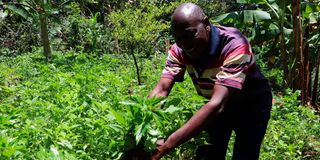Josephat Barasa: To overcome the erratic weather and harvest in plenty, I farm ‘everything’

Josephat Barasa on his four-acre farm in Elukhari village, Butula sub-county in Busia.
Josephat Barasa’s four-acre farm in Elukhari village, Butula in Busia County cuts an image of the biblical Canaan.
The farm is not only flowing with milk and honey, but also hosts different types of indigenous vegetables and fruit trees, where diverse species of birds call home.
“I use the permaculture method of farming, where my livestock, poultry, plants and bees benefit from each other while giving me and my family food and income,” he tells the Seeds of Gold.
The traditional vegetables, he says, offer him constant income that he uses to run his farm and households.
“I make at least Sh10,000 from them every week and I farm them all the year round. More income comes from milk, indigenous eggs, indigenous chicken, rabbits, timber, honey and cereals.”
Barasa’s house stands elegantly in his compound surrounded with different types of trees, most of them indigenous species. There are also several smaller houses in the compound where he accommodates agro-tourists and farmers from different parts of the country (at a fee) who stream in every week to learn more about his farming approach.
“When I bought this land 10 years ago, it was a bare field without a single tree. The owner used to grow sugarcane,” says the former teacher, who resigned to concentrate on smallholder agriculture.
“Since then, I have been transforming it into a self-sustaining farm that can produce different types of food at any given time throughout the year without use of any synthetic fertilisers or chemicals at any point,” says the father of six children.
He does not turn the soil, but uproots weeds manually and uses them to make compost manure. The heavy mulch keeps the soils moist and spongy, making it ideal for micro-organism to thrive, thereby enhancing soil fertility.
Indigenous chickens
He has divided the farm into different sections. In the main compound, he keeps more than 150 free-range indigenous chickens.
“The chickens roam around the farm eating fruits that fall from trees, insects and worms that thrive beneath the mulch,” he says. He also keeps rabbits, which, instead of feeding them, he has set aside a portion of land with different types of vegetables where the rabbits freely graze.
A short distance away there is a zero-grazing dairy unit, where the animals feed under tree shades, but they have a structure where they sleep or shelter whenever it is raining. According to Barasa, the unit was deliberately placed where it is so that all the cow dung and other wastes can be directly emptied into a huge terrace at the end of his farm.
“Whenever it rains, the nutrients from this trench leach directly into the farm, thereby nourishing the soils for healthier crops,” he says.
“When the mulch in the terrace is well-decomposed, we usually empty it and use the manure on the farm.”
The next unit is what he calls the food forest. From a far, it looks like a shrubby thicket. But from a closer look, it is a heavily mulched garden with fruit and fodder trees such as avocado, pawpaw, bananas, different berries, leucaena and guava. The food forest also features cassava and yams.
Not far from that is what he refers to as the ‘farm supermarket’. This is a section where he grows different types of indigenous vegetables during short season rains, and cereal crops such as soy beans, groundnuts, cowpeas and bush beans, apart from maize during the long rain season.
Grow maize
“I don’t need to grow maize because the crop is not profitable for smallholding. But since we must eat ugali, I prefer to buy some when other farmers are harvesting,” he says, noting he employs 16 people directly.
The last section of the farm is an indigenous forest that mimics a typical tropical rainforest. It features several indigenous tree species, shrubs and it’s home to different birds, rodents and insects that thrive in such environment. It is from this forest that he keeps bees for honey production.
“My principle on this approach is that at any given time, one should not be able to see bare soil. It has to be covered either with dead or life mulch,” he says.
Dr Million Belay, the head of the Alliance for Food Sovereignty in Africa (AFSA), notes that uniting generations of indigenous knowledge, farmer-driven and science-based innovation, and an ecosystem’s natural processes, makes agro-ecological food systems mitigate the climate crisis and even help solve it.
"Most importantly, by embedding diversity and resilience, agro-ecology provides the ability to absorb carbon and adapt to the existential threat of climate change," he said.
The Food and Agriculture Organisation of the United Nations (FAO) notes agro-ecology is a transformative paradigm that places social justice and sustainability at the centre.





